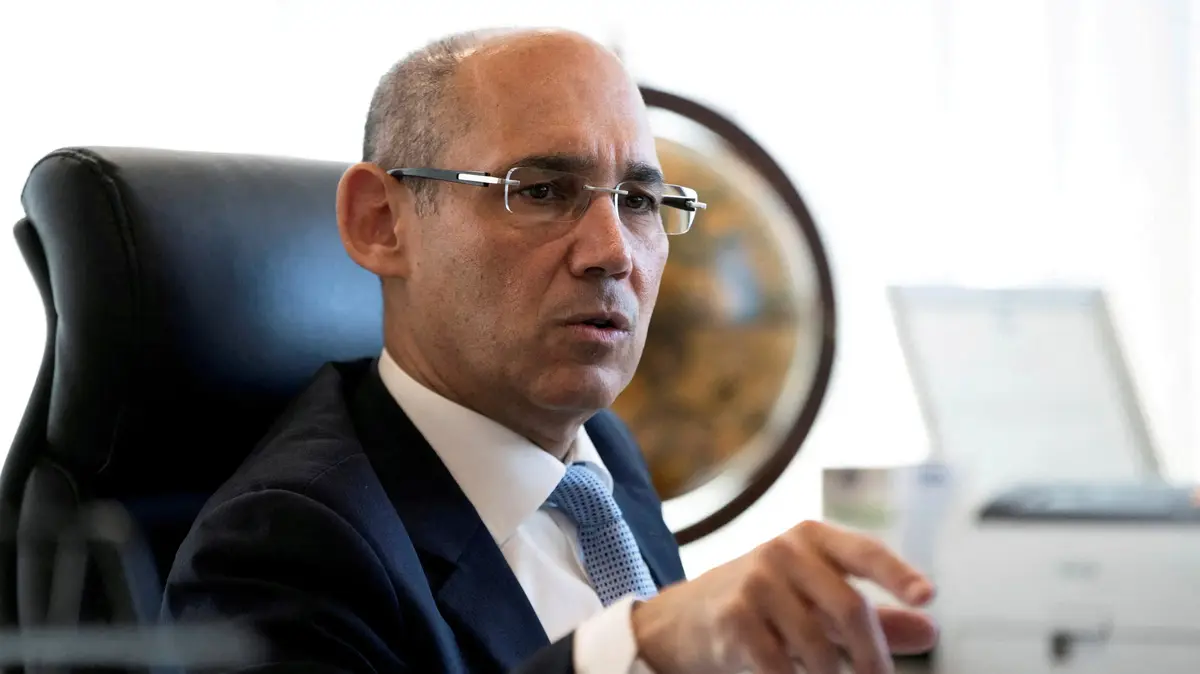European banking has a great challenge ahead if it is to be compared with the American one: to grow in size, capital and capitalization.
But it must also compete with another great enemy, big tech, firms that are taking more and more market share from banks, especially in means of payment and consumer credit, two businesses that provide outstanding income through margins and of commissions, although consumer credit has fallen as a result of the pandemic.
But first, the sector has to solve other problems arising precisely from the health crisis, and although it affects all sectors and continents, European banks, and among them the Spanish ones stand out, must combat the rise in non-performing loans due to the fall of the economy , the decrease in income due to less business activity and the desire of Spaniards to save due to fear of the effects of Covid.
Added to this are negative rates that will last for several years, almost a decade more, and a lack of solvent credit demand.
Cost reduction via office closures and staff cuts, the old recipes of always, are still the most recommended by supervisors, and in light of this, mergers maintain their prominence as a formula.
The problem is that its route is getting shorter, at least in the domestic market, according to all the bankers and experts consulted.
"In 2021 there will be some more mergers, but we do not believe that many can already occur," explain almost all the executives asked by this newspaper.
More information
Unicaja and Liberbank will allocate 378 million to reduce staff and offices and will give a 'pay out' of 50%
Santander signs the ERE with the unions that affects 3,572 employees and the closure of 1,033 offices
This is how banks take early retirement: each time with less age and less salary
During the year that has just ended, the ECB with the support of the Bank of Spain activated the merger button, which was paralyzed during the months of total confinement in the country (from March to June), but which was reactivated in the summer.
Hence the merger of CaixaBank and Bankia, to create the largest bank in Spain, with assets of 664,000 million euros.
This operation increased the pressure for other entities, such as Banco Sabadell, which appeared and appears in all pools as the candidate to star in a merger.
In Europe, on average there are 0.38 offices per inhabitant;
in Spain, 0.51
The merger of Unicaja and Liberbank was also on the table of analysts and supervisors.
They trusted that both entities could resolve their differences.
And so it has been, just at the end of the year.
On Tuesday, December 29, their respective councils approved their merger, which will give rise to the fifth Spanish bank with 110,000 million euros in assets.
But the ECB and the Bank of Spain want stronger, bigger banks that can better capitalize on the market.
The supervisor intends to avoid a banking crisis derived from the health crisis.
Hence, now his obsession is to ask the banks for "more provisions and capital, more capital," explains a prominent banker, who adds, that despite this request, "it is true that with the Covid he has relaxed the capital requirements of 8% 9%, compared to 10% or 11% in previous years.
But it is also true that the ECB knows that no bank is going to lower its capital ratio to 9%.
No entity will dare, it would be their condemnation in the market ”.
The upturn in non-performing loans after the near end of the relief measures to alleviate the economic disaster of the Covid, such as moratoriums or credits with ICO endorsement has become a headache for supervisors, which is why they insist on that banks carry out more cost cuts and increase their provisions and capital.
On the continent, the average commission is 90 euros per year, in Spain, 34
Some experts, such as Antonio Madera, director of the Axesor rating agency, believe that in the worst case scenario, defaults can rise to double digits.
Given this, he believes that the bank will react with different strategies.
There will be those banks that have carried out or will carry out important divestments, such as BBVA with the sale of its US subsidiary;
o Sabadell, which has announced that it will put its UK subsidiary TSB up for sale, or those that will bet on mergers, as has happened with CaixaBank and Bankia.
This expert maintains that mergers will continue in 2021, "but mainly within smaller entities."
It also highlights the challenge of digitization.
His opinion is shared by several executives, although practically all the sources consulted also agree that there may still be an outstanding corporate operation carried out by Sabadell.
"We do not rule out that BBVA and Sabadell will resume their negotiations for their merger, although after the replacement of Jaime Guardiola as CEO by César González-Bueno it seems more complicated," says a veteran of the sector.
"If the merger of BBVA and Sabadell had been closed as expected in November, the Spanish banking map would have been closed in 2020, except for some minor adjustments," says another financial source.
Back to the 1950s
Mergers, in any way, are aimed at cutting costs, with massive office closures and staff reduction.
Some entities, such as Banco Santander, and now Banco Sabadell, have resorted to this formula alone in 2020, the same as Ibercaja, among others.
Santander will close 1,033 branches in the coming months, and has started an ERE that affects 3,572 employees.
It is the biggest adjustment in its history.
Sabadell has closed almost 250 branches, but its goal is to close quite a few more this year, over 300, in fact, the idea is to turn the leg of the bank's retail business into a new ING, with few offices, but one highly digitized operational.
The bank's plan also involves adjusting its workforce by another 1,800 employees this year, a figure that repeats from 2020.
A manager of one of the main banks in the country assured on Tuesday that now “the real transformation of banking is beginning.
You have to reinvent yourself or die.
In the new model there will be offices, but many fewer, and those that exist will have to be reused for other services, in addition to the sale of banking products.
We must take into account the very privileged situation in which the banks' branches are located ”.
At the moment, several managers agree that with the impulse of digitization by banks and the spectacular growth in the use of online channels by customers produced in recent months due to the coronavirus, the bank has closed or announced plans to close more than 5,000 branches.
"And yet another 5,000 offices can be closed to reduce the number to less than 15,000, that is, lower the number of branches existing in 1950," explains a banker.
Santander's ERE
When Santander announced its ERE in November to the unions, it gave some clues to the reason for this measure without entering into a merger, and without a year having elapsed since its previous adjustment, which also affected more than 3,000 employees.
He assured that in recent years interest income had fallen by 59%;
there had been a sharp decline in credit.
And he stressed that unlike Europe, in Spain there was still a high density of offices per inhabitant.
Thus, while the average in the Old Continent was 0.38 offices per inhabitant, in Spain this metric is 0.51.
In addition, the assets managed by the branches in Europe are 10.28 million and in Spain this figure is reduced to 4.92 million, and the efficiency ratios in the country have gone from 45.5% to 53.3%.
To which is added a forecast of the ROE (return on equity) for the close of financial year 2020 of 2%, while the Bank of Spain estimates that it should be 7% to 8%, close to the cost of capital.
Commissions
Another hallmark of 2021 will be the rise in commissions for so far free services.
Already in the last quarter of 2020, several banks warned of their new commission policies, with flat rates for the most connected clients and high fees for the least active.
The reference: the rest of Europe.
According to a study by the Capgemini firm in Europe, the average annual commission per customer in banking is 90 euros, compared to the current 34 euros in Spain.
Santander and CaixaBank have already begun to charge 240 euros per year to unrelated customers.
New ECB control: reclassification of bad debt portfolios
Double exposure of the logos of the Unicaja and Liberbank entities.
EFE
Capital.
Spanish banks are one of the most resistant in Europe to a possible crisis, but their image is distorted when analyzing their solvency or capital ratio compared to the rest of the European banks.
According to the latest analysis by the European Banking Authority (EBA, for its acronym in English), published on December 11, Spanish banking is once again the red lantern of the sector in Europe by capital ratio.
Its solvency rises to 11.8%, only three tenths higher than that registered in March.
And it is still the lowest in Europe, with an average of 14.7%.
Dividends.
The ECB lifted the veto in Europe to distribute dividends to banks on December 15, but only in part.
They may pay up to 15% of the accumulated profit in 2019 and 2020 or not exceed 0.20 points of the CET 1 ratio of risk-weighted assets (APR).
They must choose the lower of both amounts.
But, for this, the entities must be profitable, if not, they must wait until September, when it is foreseeable that the veto will be lifted definitively.
In Spain, it is estimated that the bank will distribute some 1,500 million until that month, between 10% and 17% of its profits, always under the authorization of the supervisor.
The rest of the dividend will be given from September.
Reclassification.
Now the fear of the ECB is the increase in bad debts.
For this reason, it has initiated a special surveillance and has asked the banks to reclassify their credit portfolios that may become delinquent in summer, once the palliative measures of the governments to mitigate the economic decline, such as the moratoriums on ERTE, have been completed. and, above all, in the Spanish case, loans with an ICO guarantee.
Despite these measures, several experts consider that the default will be somewhat lower than expected at the beginning of the crisis.
Other keys to the sector
Jaime Guardiola, Josep Oliu and César González-Bueno.
Fintech competition.
The Bank of Spain has already warned on several occasions about the competition of these digital platforms.
Even their weight in the banking business is low, but no one doubts that they will rise in the future.
"In the future they will kill the alternative source of income for banking, which are commissions", reflects a banker.
Investment funds.
Another source of income is commissions for the management of investment funds or pension plans, “but in many cases they have not managed to beat indexes.
Perhaps they have to lower commissions, as the manager Francisco García Paramés has begun to do, ”explains the same banker.
Gain time.
One of the objectives of traditional banking is to buy time until interest rates start to rise.
The recipes, those already mentioned, cost reduction and mergers.
The problem is that banks like this must withstand at least 10 years, a period that experts calculate for the ECB to change its strategy and raise rates.
Governance.
This is another of the challenges for Spanish banks and one in which the national supervisor has also put its efforts.
For now, he has asked the CEOs of domestic banking to leave their executive functions.
In the case of large banks, it has already demanded that their functions be limited, something that has already been done, in the case of Ana Botín and Carlos Torres, presidents of Banco Santander and BBVA, respectively.
Josep Oliu, from Sabadell, and Manuel Azuaga, from Unicaja, will lose their executive powers in the coming months.














